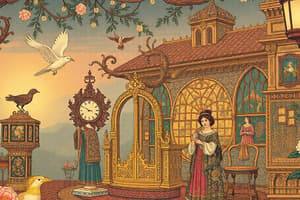Podcast
Questions and Answers
What is a primary factor that causes cultural evolution within a society?
What is a primary factor that causes cultural evolution within a society?
- A permanent adherence to historical traditions
- Modification or replacement of norms that no longer satisfy the members (correct)
- Satisfaction from existing norms
- A significant increase in the population size
Which of the following best describes how culture influences consumer behavior?
Which of the following best describes how culture influences consumer behavior?
- Culture provides shared meanings that guide consumer preferences and purchases (correct)
- Culture limits consumer choices to only traditional products
- Culture has no measurable impact on purchasing decisions
- Culture dictates a single correct way to consume products
In the context of cultural dynamics, which statement is true regarding companies' responses to cultural changes?
In the context of cultural dynamics, which statement is true regarding companies' responses to cultural changes?
- Companies are often slow to recognize cultural shifts and adapt their products accordingly
- Only luxury brands can successfully respond to cultural dynamics
- Companies that detect cultural changes early are better prepared to adapt their products (correct)
- Cultural changes do not affect the product offerings of companies
How does culture function in relation to the consumption of services?
How does culture function in relation to the consumption of services?
What role do myths play within the cultural process as described in consumer behavior?
What role do myths play within the cultural process as described in consumer behavior?
How do consumers primarily buy products according to the cultural perspective described?
How do consumers primarily buy products according to the cultural perspective described?
What role do companies play in the creation of popular culture?
What role do companies play in the creation of popular culture?
What is a primary characteristic of myths as described?
What is a primary characteristic of myths as described?
According to the content, why do myths often address existential questions?
According to the content, why do myths often address existential questions?
In what way do children's stories function as myths?
In what way do children's stories function as myths?
How do commercial campaigns utilize mythology?
How do commercial campaigns utilize mythology?
What is a common misconception about the nature of myths?
What is a common misconception about the nature of myths?
How did the incorporation of women into the workforce impact family structures?
How did the incorporation of women into the workforce impact family structures?
What marketing strategy is commonly used to embed products into cultural contexts?
What marketing strategy is commonly used to embed products into cultural contexts?
What effect has American television had on global culture?
What effect has American television had on global culture?
In what way does advertising convey cultural meanings related to consumer products?
In what way does advertising convey cultural meanings related to consumer products?
What market segment did Audi target with the A3 model?
What market segment did Audi target with the A3 model?
What role do professional athletes have in brand promotion?
What role do professional athletes have in brand promotion?
How does advertising influence informal cultural learning?
How does advertising influence informal cultural learning?
What type of cultural shifts led to the development of a new market for smaller premium cars?
What type of cultural shifts led to the development of a new market for smaller premium cars?
Flashcards
What is culture?
What is culture?
Culture is a living system of beliefs, values, customs, and traditions that influence behavior within a society. It's like a shared blueprint for how people interact and make decisions.
Is culture static?
Is culture static?
Culture is constantly evolving and adapting to changing needs and desires. It's like a river, always flowing, sometimes changing its course.
How do companies benefit from cultural awareness?
How do companies benefit from cultural awareness?
Businesses that can identify and react to cultural shifts early have a competitive advantage. They offer products that resonate with the new cultural realities.
Why is cultural meaning important in marketing?
Why is cultural meaning important in marketing?
Signup and view all the flashcards
How does culture affect consumer behavior?
How does culture affect consumer behavior?
Signup and view all the flashcards
Cultural Change and New Market Segments
Cultural Change and New Market Segments
Signup and view all the flashcards
Product Placement (or Positioning)
Product Placement (or Positioning)
Signup and view all the flashcards
Cultural Meaning in Advertising
Cultural Meaning in Advertising
Signup and view all the flashcards
Television's Impact on Culture
Television's Impact on Culture
Signup and view all the flashcards
Athletes as Brand Ambassadors
Athletes as Brand Ambassadors
Signup and view all the flashcards
Cultural Awareness for Businesses
Cultural Awareness for Businesses
Signup and view all the flashcards
Marketing and Cultural Learning
Marketing and Cultural Learning
Signup and view all the flashcards
Advertising and Symbolic Meaning
Advertising and Symbolic Meaning
Signup and view all the flashcards
Symbolic Consumption
Symbolic Consumption
Signup and view all the flashcards
Cultural Production System
Cultural Production System
Signup and view all the flashcards
Myths in Culture
Myths in Culture
Signup and view all the flashcards
Symbolism in Myth
Symbolism in Myth
Signup and view all the flashcards
Myth's Function
Myth's Function
Signup and view all the flashcards
Mythological Marketing
Mythological Marketing
Signup and view all the flashcards
Cultural Process
Cultural Process
Signup and view all the flashcards
Study Notes
Consumer Behaviour
- Culture is dynamic and evolves over time.
- Culture affects daily consumer behavior.
- Cultural creation is influenced by various factors.
- Marketing can shape and influence culture.
Cultural Dynamics
- Culture is not static; it changes gradually.
- Cultural norms evolve to meet societal needs.
- Cultural changes occur slowly, possibly imperceptibly.
- Companies prepared to recognize changing trends are best positioned to adapt.
Cultural Dynamics: Example
- Premium car brands initially targeted a specific demographic (middle-aged, high-income men with children).
- Social changes (women entering the workforce and smaller family structures) created a new market segment.
- Audi's response to this change, the A3 model, was successful, outperforming competitors for a period of time.
Sale of Services and Culture
- Marketing influences informal cultural learning by communicating values, and suggesting ways products fulfill societal needs.
- Product placement in media (e.g., movies, TV) influences consumer behavior and creates cultural meaning around products.
- Television's influence on culture is significant, especially in disseminating products, music, and related values.
Sale of Services and Culture: Example
- Brands collaborate with film producers to showcase products within films (e.g., BMW cars in Mission: Impossible).
- This placement is a form of cultural transmission through mass media.
Questions
- What role do professional athletes have in brand promotion, and can one athlete significantly boost brand image?
- How has sport as entertainment transformed Spanish culture?
- What is the future of professional sports, considering potential economic impacts?
- How has culture affected the trajectory and modernization of the sports industry?
- Does culture influence consumer behavior, and how?
Sale of Services and Culture: Further Insights
- Advertising crafts cultural meaning for products, influencing customers' perceptions.
- Consumers buy products not only for their functionality but also for their symbolic meaning.
- Products create self-images through shared cultural meanings, impacting purchase decisions.
The Actors of the Cultural Process
- No single entity (designer, company, or agency) is wholly accountable for creating widespread cultural impact.
- The creation and dissemination of cultural products are collaborative efforts.
- Various actors—individuals and organizations—work together within a complex system.
The Myths
- Myths are narratives explaining societal origins, concepts, and events.
- Myths are crucial to understanding group values and beliefs.
- They explore fundamental elements influencing social groups.
- Often involve supernatural elements or symbolic interpretations for better understanding
- Myths, found in myths and stories can communicate values and moral lessons.
The Myths: Further Insights
- The advertising industry uses mythological structure in campaigns.
- Products presented in campaigns can be akin to a hero that addresses a need.
- The use of professional athletes in advertising or other marketing strategies could be a response to this method and enhance the brand's recognition.
The System of Cultural Production
- Cultural production involves various subsystems working together.
- A creative subsystem innovates with new ideas.
- An administrative subsystem handles production, distribution, and other logistical factors.
- A communications subsystem shapes the meaning and use of the generated cultural elements.
The System of Cultural Production: Further Insights
- Cultural guardians (e.g., critics, journalists, influencers) can significantly affect a product's popularity.
- These guardians heavily influence whether or not products gain wider adoption within the society
Culture and Consumer Behaviour
- Culture heavily influences behaviour among a group.
- Culture guides and directs individual behaviours.
- Marketing uses culture to understand the purchasing behaviour of a group.
Culture and Consumer Behaviour: Example
- Male consumers' use of cosmetics became more prevalent.
- Companies reacted by changing previously established marketing approaches.
- This change was an example of how understanding and adapting to existing cultural influences is crucial for marketing.
Conclusions
- Culture is dynamic and evolves over time.
- Marketing plays a key role in the cultural creation process, shaping consumer behavior and creating new trends.
- Cultural production involves a complex network of interconnected actors.
- Cultural shifts can create new market segments.
Bibliographic References
- Several established marketing textbooks and authors are cited.
Studying That Suits You
Use AI to generate personalized quizzes and flashcards to suit your learning preferences.




